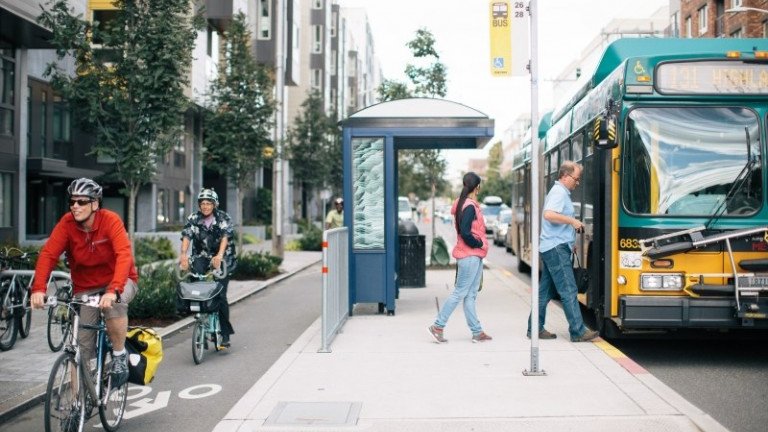Shape the Next 20 years of Walking, Biking, and Rolling in Seattle

- JoshHolland
- Oct. 16, 2023
The Seattle Department of Transportation (SDOT) has been busy crafting the Seattle Transportation Plan (STP) that will shape the next 20 years of our streets, sidewalks, bike lanes, trails, transit networks, and public spaces. During extensive community outreach, SDOT asked whether people wanted a plan that will “stay the course,” pursue “moderate pace,” or “rapid progress,” and Seattleites overwhelmingly (95%) support rapid progress towards transformational change!
Unfortunately, the first draft plan fails to live up to that vision:
- It fails to include redesigns of our most dangerous streets like Aurora Ave, Rainier Ave S, Lake City Way, MLK Way S, and 4th Ave S. And it fails to lay out a credible pathway to reaching zero traffic fatalities and serious injuries by 2030 (Seattle’s adopted Vision Zero goal).
- It fails to include any specific pedestrian-only streets — not even Pike Place Market.
- It fails to show how we will reach our climate goals to reduce emissions by doubling the number of people biking by 2030.
The good news is that with your help, we can remake the Seattle Transportation Plan to meet the city’s climate, safety, and equity goals — with urgency and accountability.

How to Improve the Seattle Transportation Plan
To make sure the plan effectively moves Seattlites in years to come and reduces emissions and traffic fatalities, SDOT needs to make the following improvements to the plan:
- A Clear Vision: Restore the previously included goal to have walking, rolling, biking, and transit be the most convenient way to get where you need to go, rather than just making it possible to walk, roll, or bike.
- Rapid progress: Pick the rapid progress alternative that 95% of the public wanted and revise the plan to achieve it.
- Safety: Show a credible plan (like Seattle Neighborhood Greeneways proposed last year) for how the city will reach Vision Zero by 2030, including redesigning our most dangerous streets, and adopt a policy that all streets should only have at most one car lane in each direction (80% of people walking are run over on streets with more than one lane of traffic).
- Climate: Rapidly increase investments in bike, pedestrian, and transit networks to meet the city’s ambitious goals so that by 2030, 7% of trips are by bike, 24% walking or rolling, 24% by transit, 10% in electric private cars, and 35% or fewer non-electric private cars. Require every project be designed so that it contributes to this goal. This must include a strategy to rapidly roll out a network of safe and convenient bike routes to where people need to go and pedestrianized streets or zones at the heart of every neighborhood.
- Equity: Meet Transportation Equity Framework commitments by 2028. Improve safety and prioritize investments in communities with histories of disinvestment. Do this work in tandem with strict anti-displacement measures, community engagement, and expanded affordable housing options on non-arterial streets.
- Accessibility: Make our city accessible for the 25% of residents that are non-drivers. Demonstrate that the city is complying with the ADA consent decree (and go further!)
- Accountability: Set specific, measurable, achievable, and timely goals to hold ourselves accountable to change.
- Process Reform: Too many projects get bogged down with seemingly endless processes that do not result in better outcomes. Community engagement for safety projects should be short and seek to understand and mitigate any real harms. Community engagement for projects that are primarily about creating community spaces should reflect community needs and desires.
- Get the Details Right: Features like diverters, bollards, and concrete bike lane protection (not floppy plastic posts) should be standard to make our streets safer and more welcoming.
- Transparency: The public needs a second opportunity to comment on a new draft plan before it is finalized and sent to City Council.
Three easy ways to Influence the STP Before Oct 31
- Send an email to the Seattle Department of Transportation.
- Use the comment box on the Seattle Transportation Plan Online Engagement Hub to tell SDOT “Seattle should pursue rapid change. It should prioritize the movement of transit, cyclists, and pedestrians over cars to move faster towards a zero emissions and traffic safety collisions in Seattle.”
- Forward this email to a friend. Word of mouth is a powerful form of advocacy.